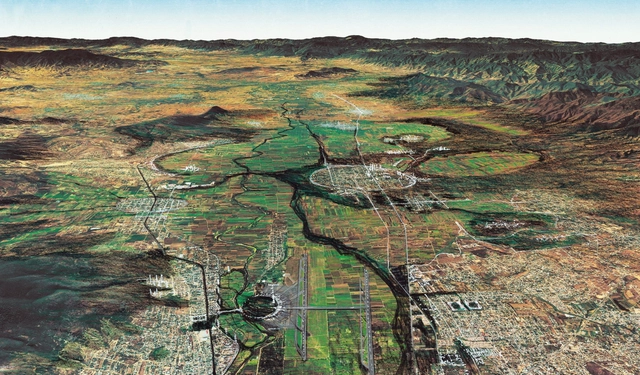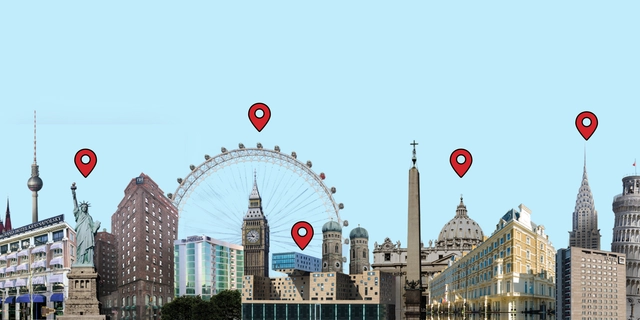Mars House designed in May 2020 by Artist Krista Kim, has become the first sold digital NFT home in the world. The 3D digital file that can be experienced in virtual reality, was just acquired. Rendered using Unreal Engine, a software used to create video games, the house can be experienced in VR, but could also be experienced through augmented reality (AR) environment in apps. A structure comprised of light, Mars House generates a healing atmosphere, with a musical accompaniment by Jeff Schroeder of The Smashing Pumpkins.
COVID-19: The Latest Architecture and News
Mars House, First Digital Home to be Sold on the NFT Marketplace
COVID-Ready Office Design: Retrofitting Buildings with Social Distancing in Mind

The 2020 COVID-19 outbreak has deeply redefined our relationship to public spaces. Fear of transmission (both direct and indirect) has closed schools, restaurants, office buildings, and transportation hubs, and has limited access to other densely populated locations and shared spaces. We have also learned that COVID-19 primarily transmits through the spread of water droplets from infected individuals, especially in scenarios of close contact, such as prolonged indoor activities. As a result, new building regulations have been put in place that reduce the circumstances in which the disease can spread. These safety precautions include mask mandates, redesign of ventilation systems, and social distancing policies. In this article, we will focus on social distancing.
Tech, Class, Cynicism, and Pandemic Real Estate

It didn’t take long for the coronavirus pandemic to inspire both cutting-edge architectural design solutions and broad speculation about future developments in the field. Many of the realized innovations have been contracted by or marketed to the real estate sector. But as firms compete to provide pandemic comforts to rich tenants, the COVID-19 technology that directly affects working-class communities is mostly limited to restrictive measures that fail to address already-urgent residential health hazards or administrative conveniences for developers that allow them to circumvent public scrutiny. These changes had been long-planned, but they have found a new license under the pretext of coronavirus precaution. In terms of “corona grifting,” this sort of thing takes the cake.
The Religion of the City: Cars, Mass Transit and Coronavirus

Religion is a uniquely human reality. As are cities. As we emerge from our burrows of sequestration, the silent cities and places of worship will become human again, versus the present sad memory of what they once were.
We will recover from another human reality, the pandemic and when we do we will be forced to address some questions. Before this century, the automobile was once seen as the way Americans could create a new reality: a huge middle class that could control its life by using the freedom that cars gave them to go where they wanted, when they wanted, and to live where they wanted. Before this latest change of sequestration, that vision of what cars meant to our culture was changing —especially in cities.
Gentrification and Dystopia: The Future of Mexico City in the Aftermath of the Covid-19 Pandemic

When looking at the population of the world's metropolises, in this case Mexico City, the reality is that the majority of the people living there have migrated from other regions of the country and, sometimes, from other countries as well. Of course, thanks to the Covid-19 pandemic, companies and schools have gone virtual, and, with their work and studies no longer tied to urban centers, people have left in masse for the coast and other less populated areas in search of space and lower living costs.
Pipe and Fittings: a Modular Kit to Shape Structures for Social Distancing

The global COVID-19 pandemic has forced us all to adapt quickly to new ways of living: new ways of working, communicating, buying groceries, and so much more. That adaptability is the key to navigating our changing world. Modular and flexible building systems can help us adapt our physical spaces to the new realities of social distancing or even to the need for rapidly deploying field hospitals.
Has the Pandemic Changed the Experience of Encountering Art in Public?

Public art is an innate cultural privilege for New Yorkers. Top-notch art can be found across the city’s boroughs everywhere from parks, squares, alleys, and rooftops—sometimes to the jaded disdain of passerby. While permanent staples, such as Robert Indiana’s Love on 6th Avenue or George Segal’s Gay Liberation at the Stonewall National Monument are ingrained in the urban texture, others are more ephemeral. Public art has the power to swiftly take over Instagram feeds but also has a history of sparking polarizing interpretations at town hall hearings.
COVID-19 Contributed to Sharp Decline in Completed Skyscrapers in 2020

It’s a given that the coronavirus pandemic has had wide-ranging impacts on construction projects large and small over the past 10 months. So, what about the construction of new buildings that share the defining characteristic of being superlatively tall?
As detailed in an annual report published earlier this month by the Chicago-headquartered Council on Tall Buildings and Urban Habitat (CTBUH), newly completed skyscrapers experienced a global decline of 20 percent in 2020 compared to the previous year due, both directly and indirectly, to the COVID-19 crisis.
Why Are Countries Building Their Cities From Scratch?

Imagine having a blank canvas on which to master-plan a brand new city; drawing its roads, homes, commerces, and public spaces on a fresh slate and crafting its unique urban identity. Every urban planner has fantasized about designing a city from scratch and luckily for some, this dream is morphing into concrete opportunities.
Over the last two decades, new, master-planned cities have emerged from the ground up at an unprecedented scale, the majority of which have been created in Asia, the Middle East, Africa, and Latin America, with currently over 150 new cities in the making. This new type of urban development has shown to be particularly seductive in emerging markets, where they are sold as key parts of the strategy to leapfrog from agriculture and resource-based systems to knowledge economies by attracting foreign capital and boosting economic growth.
Future of Urbanism in China: How Can We Build a Livable City?

As we are entering 2021 after a year of anxiety and uncertainties, what are your expectation for our future? The UN75 survey reports that most people around the world hold greater optimism for the future: “Globally, many more respondents believe people will be better off in 2045 than today (49%) compared to those who believe people will be worse off (32%).”
Cleaning Spaces With Light: Ultraviolet Radiation To Kill Viruses and Bacteria

In dystopian films, it is a common trope to depict the sky as filled with a thick fog, blocking the sun's rays and bringing a dark atmosphere to the scenes. Whether in Blade Runner or in a Black Mirror episode, the lack of sun commonly represents a future we would rather not live in. The sun provides heat to planet Earth and is a great source of light energy, essential for the survival of many living creatures. We can generate electricity from the sun and still use only a fraction of the energy it provides. Sunlight also regulates our circadian cycle, which affects our mood. But recent forest fires and industrial pollution in some large cities have already made the dystopian blockage of sun a relatively common phenomenon, depriving hours of sunshine from many inhabitants. Concurrently, with the COVID-19 pandemic, we are living a plot that few science fiction writers could have predicted, and new technologies and solutions have emerged to try to contain the spread of this invisible enemy. Can the sun, or specifically ultraviolet radiation, kill viruses and bacteria? Could it kill the coronavirus?











(1).jpg?1614161719&format=webp&width=640&height=580)
.jpg?1614161736)



(1).jpg?1614161719)


.jpg?1611548432)

_22.43.53_(1).jpg?1611548822)


(%C2%A9minorormajor).jpg?1612954566)







.jpg?1611288061)


